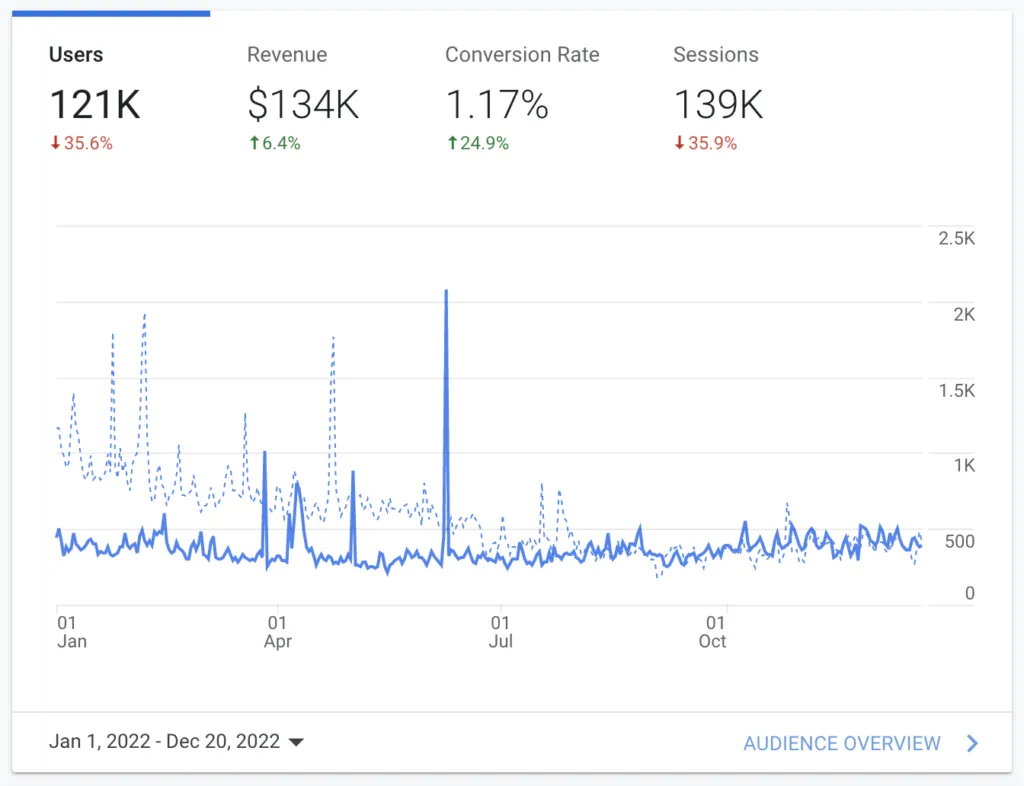TL;DR: these are some of the same strategies I have used on my clients’ websites. Below is an example of a client’s revenue for 2022 so far.

Having an efficient eCommerce web design in this day and age is vital—unless you completely skipped the past couple of years. It will ensure both, that your customers and clients are always returning to your site and that you’re generating sales as often as possible.
In order to have your eCommerce website convert as many of its visitors into customers as humanly feasible, there are some practices you’ll need to follow.
To learn more about these eCommerce ninja practices, continue reading below! 🥷
Choosing the Right Platform for eCommerce Web Design
If you want to have a website that improves conversions, you need to choose a platform that will serve the needs of your website. WooCommerce is a WordPress plugin that allows you to turn your website into an eCommerce site.

You can decide to use a web-based WordPress account or a self-installed version of the famous CMS platform. The difference between the two is that the first one is managed and hosted by WordPress itself while the other is the CMS software that you install on your own server—sweet!
This plugin is free—download WooCommerce; however, you may have to pay an extra fee if you want to install some add-on features as well such as UPS shipping or payment gateways like Stripe.
Using Google Analytics for Conversions
Google Analytics is a must-have tool for those eCommerce shop owners who are trying to find the best ways to track conversions to their site. If you’re planning to use the basic version of Google Analytics, you can use this tool for free.
In order to take advantage of this tool’s basic tracking information or data, you’ll have to install the the tracking number you’re given onto your website pages or via a plugin for your CMS like WordPress, Drupal or Shopify.
By tracking your conversions with Google Analytics, you can analyze which pages and which tactics are working best for your business. This way, you can maintain a trend that will improve conversion rates on your eCommerce website.

Using Google Analytics to Track Sales
Aside from using Google Analytics to track your conversions, you can also use it to track the dollar amount your sales efficiently. Much like using this tool for conversions, you’ll need to add additional tracking code to your website’s pages.
By using Google Analytics to track your sales, you can also observe which pages attract the most sales from your customers. As such, you can attempt to use similar techniques on all your pages and in doing so, you can begin to boost your sales.
Read more about setting up eCommerce tracking on your website!
Creating a Minimalist eCommerce Web Design
When it comes down to conversions, your website says a lot. If you want to have as many conversions as possible, you may also want to design your website to be minimalist.

Minimalism attempts to create websites that are to-the-point and that are dynamic. There are a few benefits to having this kind of eCommerce web design; among them, is that your customers will appreciate the simplicity of using your website.
When you have a minimalist website, you’re ensuring that all of your customers can find your information with complete ease. Not only this, but having a minimalist site also allows you to keeps its maintenance to a minimum. When your website is cluttered with information, it becomes difficult to maintain all of the information over time.
Minimalist websites will need less updates and there will be less information for you to change. This way, you customers will always have a clear understanding of your website’s purpose.
Optimize Your eCommerce Web Design
Search engine optimizations or SEO has made headlines in recent years as it is known as the best strategy for increasing leads and conversions to websites and eCommerce shop products. Search engine optimization takes advantage of keywords, meta descriptions, and more to cause a website to rank higher in search engines like Google.

The higher a website ranks in Google, the more accessible it is to potential customers and clients.
As such, you can expect to experience a higher volume of conversions when you implement search engine optimization and a quick way to do this is to hire a SEO writer to optimize your content for search engines.
Testing and Making Changes Based on User Activity
Your users will determine how your entire website runs. If you’re not sure about which eCommerce web design to go with, you should consider testing it out first. You can go through several website designs over time and as such, you can have a solid idea of what your customers appreciate and what triggers them to shop what you sell.

When you test out designs, you’ll be able to observe your conversions and leads over time. You’ll be able to see, then, which designs work best for your specific clientele or audience.
Putting Your Products on Google Shopping
Google Shopping is part of Google Ads. There is a major difference between the two, though, that being: Google Shopping allows customers to view and search for items that might interest them. As such, putting your products on Google Shopping can allow more potential customers to discover you when they’re looking for products.
The best part of this tool is that the amount of money you pay depends entirely on how much you want your products to be seen. If, for example, you get a large amount of traffic from Google Shopping, you might end up paying $100 per day. That said, it is well worth it when you see how much money you’ll be making in the long run.
Some decide to use Google Shopping until their business is more established and once it is, they don’t feel the need to use this marketing tool anymore.

The combination of increased exposure and targeted marketing can significantly increase your conversions. The more conversions you have, the more sales you’ll see on your site.
Optimizing Your Shopping Cart
Your shopping cart says a lot about your overall business. That’s why the way it’s been designed will be a major factor in determining whether your customers return and/or buy from you. One of the best ways to design a shopping cart that attracts more conversions is to offer your customers or clients free shipping upon checking out.
More often than not, customers are will be more interested in a product if they have free shipping and they’re more likely to buy from you if you’re offering it to them.

Creating a Rewards Program for your eCommerce Web Design
If you want to have people continuously coming back for more, you may want to consider giving them an incentive to do so. Some companies decide to provide people with points for every dollar purchased. After a certain number of points have been accumulated, a gift card can be provided to the customer in question.
You can also create a rewards program that will provide your store with cash upon receiving a predetermined number of points. If you create a rewards program like this, you can set yourself apart from the competitions by showing your customers that you appreciate their loyalty.
Shopify has a great app called Smile that allows Shopify store owners to do just that! WooCommerce has one rewards extension too in case you use WordPress along with this amazing cart solution.

Providing the Right Product Descriptions
The best eCommerce web designs focus on product descriptions. These product descriptions are what inform your customers or clients on what they should expect from you and your site’s products. You can tell them what your products are made of, the story behind the products, and more.

When customers and clients know what they’re buying, they’ll feel like they’re making an investment in your company and as such, they’ll be willing to buy more from you.
Conclusion
eCommerce web design is a vital component of any website. Having an overall design that considers the needs of your clients will ensure that you experience more conversions over time.
We know the importance of having the right tools for your website and it is why we’ve created this eCommerce conversions guide for you.
If you have any questions about eCommerce or about how we can help you, let us know! We’ll answer all of your inquiries as efficiently as possible.











